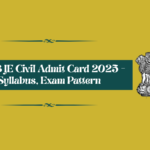JKSSB Junior Engineer 508 vacancies: How to crack it?
The application process will start soon in May 2025. Candidates who want to get the job must know the exam pattern and syllabus. The entrance test will be 120 minutes duration. We have given the syllabus and exam pattern below.
Marks120

Time duration 120
Question type-Multiple Objective
The questions will be set in English Language only.
There will be Negative Marking for each wrong answer to the extent of one-fourth of marks assigned to that question.
ABBREVIATIONS:
- OM-Open Merit,
- SC-Scheduled Castes,
- ST-Scheduled Tribes,
- RBA-Residents of Backward Areas,
- EWS-Economically Weaker Sections,
- OBC- Other Backward Classes,
- ALC/IB- Residents of areas adjoining Line of Actual control/International Border,
- ESM- Ex-Servicemen,
- PwD- Person with Disability,
- DV- Document Verification.
JKSSB Junior Engineer 508 vacancies: How to crack it?
Syllabus
Surveying: 10 Marks
Importance of surveying, principles and classifications, measurements of distance and directions, chain surveying, compass surveying, leveling, tachometry, the odolite, traversing, contouring, plane table surveying, curves.
Mechanics and Structural analysis: 15 Marks
Introduction, Concept of rigid body scalar and vector quantities, Laws of force, moment, friction, Centre of gravity, simple machines, torsion, Properties of material, Bending moment and shear force in statically determinate beams. Simple stress and strain relationship. Stress and strain in two dimensions, principal stresses, stress transformation. Simple bending theory, flexural and shear stresses, unsymmetrical bending, shear Centre. Thin-walled pressure vessels, uniform torsion, buckling of column, combined and direct bending stresses. slope and deflection, Analysis of trusses
RCC Structures: 15 Marks
Concrete technology, Ingredients of concrete, water cement ratio, workability properties of concrete, admixtures, special concretes, Nondestructive tests, basics of mix design. Concrete design-basic working stress and limit state design concepts. analysis of ultimate load capacity and design of members subjected to flexure, shear, compression and torsion by limit state methods. Basic elements of pre-stressed concrete, analysis of beam sections at transfer and service loads, one-way slab, twoway slab.
Soil Mechanics: 10 Marks
Origin of soils, properties, soil classification, three phase system, fundamental definitions, relationship and interrelationship, flow of water through soils, permeability & seepage, effective stress principle, deformation of soils, consolidation, compaction, shear strength characteristics, plate load test, SPT, Density control, Measurement of field density by core cutter and sand replacement method, soil exploration, bearing capacity and its methods
Fluid Mechanics and Hydraulics: 15 Marks
Properties of fluids, hydrostatic pressure, measurement of pressure, flow measurements, flow through pipes, flow through open channels, hydraulic pumps, principle of conservation of mass, momentum, energy and corresponding equations, potential flow, applications of momentum and Bernoulli’s equation, laminar and turbulent flow, flow in pipes, pipe networks. Concept of boundary layer and its growth. Uniform flow, critical flow and gradually varied flow in channels, specific energy concept, hydraulic jump Forces on immersed bodies, flow measurements in channels, tanks and pipes. Dimensional analysis and hydraulic modeling Kinematics of flow.
Irrigation Engineering: 10 Marks
Introduction, water requirement of crops, hydrological cycle, Dams, Canals, dams, canal head works and regulatory works, cross drainage works, hydraulic structures, river training works, water-logging, drainage, groundwater recharge, well hydraulics.
Water supply and waste water Engineering: 10 Marks
Introduction, quantity of water, quality of water, water treatment, conveyance of water, laying out of pipes, building water supply, water supply fixtures and installation, plumbing, sewerage system, laying and construction of sewers, sewage characteristics, Methods of disposal, sewage treatment, building drainage, air and noise pollution
Highway Engineering: 10 Marks
History of development of highway and planning, Definitions of various terms used in highway engineering., Methods of road construction, IRC classification, Highway survey sand plans Geometric design, Different types of road materials in use, Binders, Types of pavement, CBR method, sub grade preparation, WBM, WMM, Bituminous Macadam, dense bituminous macadam, special problems in hill road.
.Railway Engineering: 10 Marks
History of Indian railways, Gauges used, permanent way its components, Types of rails, creep, welding, Rail fixtures and fastenings, Signaling, Points and Crossings, Bridge terminology, classification, components, foundations.
Construction planning management: 15 Marks
Network diagrams, PERT-CPM, cost optimization contracts, tenders, depreciation, valuation, organization, measurement books, cash book, functions of management, construction planning, quality control, inventory control, Estimation and costing definitions, methods of estimation and type of estimates.



